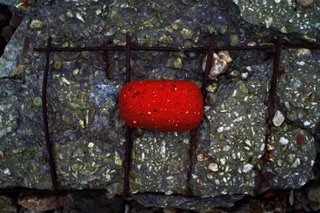 Patarei prison - Walking to the harbor a lone man looks out into the sea. Dirty sea gulls swoop on polluted fish. The ferry cuts through afternoon fog on its way home from Helsinki. The old man tugs at his fur collared coat. Another piece of rubble washes up to his feet. He kicks a stone. He kicks a brick. He kicks.
Patarei prison - Walking to the harbor a lone man looks out into the sea. Dirty sea gulls swoop on polluted fish. The ferry cuts through afternoon fog on its way home from Helsinki. The old man tugs at his fur collared coat. Another piece of rubble washes up to his feet. He kicks a stone. He kicks a brick. He kicks.
Frayed barbwire performs around a broken building to the mans left. He kicks a brick. At one time, that buiilding was s a naval fortress when Russia started preparing a huge network of fortresses. Four big forts were planned at the western side of Tallinn with a stone cannon house in the middle. These forts were supposed to protect both the continental and coastal front. This was the first fort to be built there. Alas, it was also the only of the four that was ever completed. WIthin the complex were two big stone buildings, earthworks, ditches and many other secret things.
Due to the function of defence and accommodation of the main building, the whole complex was officially called Defence Barracks. After completd though ordinary people started to call them first Battery Barracks (in Estonian: Patarei kasarmud) and then simply Battery (Patarei). The year was 1829 when Russian began building Patarei and it was completed in 1840. The Battery held 2000 prisoners.
Soon the Crimean Wars struck the area. In august 1854, the Anglo-French fleet quickly and efficiently conquered all the parts of the Åland fortress. The Russians abandoned all smaller forts stocked by sea route and supplemented the land-supported forts, including Tallinn. It was probably the formidable reputation of the Russian infantry that saved the barracks from attacks from the sea and subsequent destruction.
After the Crimean War, Tallinn was struck off the list of fortified towns and the special defence barracks became ordinary barracks. The prison was extended by 48 solitary cells in 1932 for housing those sentenced to death and serving life. The prisoners built these houses of limestone, concrete blocks, and roof tiles. The old man kicks a rock and sees a tile in it.
The prison almost emptied in 1938 in connection with the 20th anniversary of the Republic of Estonia. The extensive amnesty freed many prisoners, including most political prisoners. By the coup d'état in 1940 there were only a few non-political inmates who were set free with the help of Soviet armoured cars. However the prison life continued both during the German and the new Soviet occupation, but now the number of inmates had grown too big for the old building. The Patarai was slowly crumbling apart.
After the falling of the Soviet regime in 1991, plans to close down the totally outdated central prison emerged at once. It was suggested in the early 2000s to give the Patarei buildings to the Estonian Academy of Arts who could have moved all its activities there. Unfortunately, it was a bad timing for the Academy and the new government clearly expressed its doubts about the whole idea. A scandal broke out in connection with the finances of one private college and the idea of subsidising universities was less and less appealing.
Now a museum is currently organising 'prison adventures' for visitors. After a dangerous fungus was found in the building last autumn the prison was for a short time closed. Today it seemed abandoned. Tomorrow it will too. I shimmy up some rocks that used to be a sea cliff wall and emerge in a midst of barbwire. Navigating through the spider web of spikes I make it to the corner where an electric fence greets me. An electric fence stares back at me. Standing ten feet above the cold ocean on a sea cliff surrounded by barb wire I decide to quickly touch the electric fence. Test it. Moving at the speed of a hummingbirds wing I graze the wires. The old man kicks a brick.
The entire beach is covered with bricks, concrete slabs, and tiles. These artifacts of the prison seem like normal rocks. Just pieces of sediment. Being worn to dust. I look up at the old prison watchtower and imagine the worn down brick at my feet in its original form. Much like the prisoners. At one time a hardened criminal. Blunt and bulky. Maybe a part of a larger group of criminals held together by the mortar of money, drugs, violent tendencies. The prison is set up to take these people and dull them down. Smooth them out. Teach them to be soft and cuddly like a stuffed animal. To integrate with the rest of the soft cuddly people. The prison breaks them down day after day until they are free to go. 
Now the prison is the prisoner being worn down. Another blunt piece of detritus washing up to shore smooth and illuminated in color. These old bricks litter the beach for old men to kick. 150 years ago, not even the largest French fleet could defeat this wall let alone kick it mockingly. Yet, the old man kicks a brick.
January 10, 2007
Patarei prison
Subscribe to:
Post Comments (Atom)













No comments:
Post a Comment